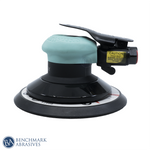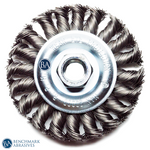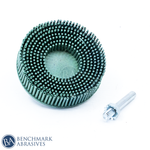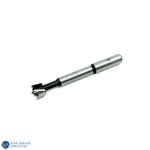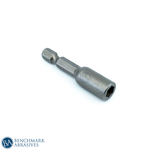
DIY Knife Making: Tips And Techniques For Sharpening With Abrasives

Regardless of your level of culinary expertise or outdoor prowess, your knives will undoubtedly see considerable use. A dull blade can be hazardous as well as challenging to cut with because it requires more effort to cut through the material you're missing, increasing the risk of cutting yourself. Thankfully, you can easily sharpen and grind a knife by yourself using standard sharpening tools like a hone rod or whetstone, as well as unconventional ones like a mousepad, sandpaper, or even a coffee mug. To find out how to sharpen knives, continue reading this article!
A. USING A WHETSTONE
STEP 1: IF NECESSARY, WET YOUR STONE WITH WATER OR HONING OIL.
To find out if and how to oil your sharpening stone, consult the manufacturer's instructions. The sharpening stone you're using will determine whether or not it has to be lubricated with water, oil, or neither. While you sharpen your knife, lubricate the entire stone and keep it moist.
- Applying lubrication will facilitate the blade's passage over the stone and prevent steel shavings—a residue left over from sharpening—from blocking the stone's pores.
- You can use mineral oil, vegetable oil, or window cleaner in place of hone oil if you don't have any.
STEP 2: CHOOSE THE PROPER ANGLE FOR YOUR KNIFE SHARPENING.
Continue to sharpen your knife at the same angle as you did the first time. Ask the maker of your knife or inquire at a reputable knife store to find quality abrasives and determine what angle is suitable for your particular knife. If you must make an automatic choice, pick an angle between 10° and 30° on either side.
- A decent compromise between the two is between 15° and 20° since shallower angles produce a sharper edge that breaks more quickly, while steeper angles endure longer.
- A different angle will require much more time to sharpen, and it can take several attempts to smooth out any uneven angles.
STEP 3: MOVE THE BLADE ACROSS THE STONE'S ABRASIVE SURFACE.
Pull the blade edge towards the direction of the stone instead of away, as though you were trying to remove the stone's outermost layer. Here, you should lightly press the knife, starting at the heel (also known as the base) and finishing at the tip, all the while keeping your 20° angle.
- This method of dragging the knife will help keep the edge of your blade symmetrical, allow a burr to form on the stone, and increase the stone's lifespan.
- Whetstones typically have varying grits on each side. To determine which side is which, look at the grit on the stone or the box that the stone was shipped in.
- Use an angle guide to estimate an angle of 20°. Used to approximate a 20° angle.
STEP 4: PERFORM THIS MOVEMENT ON BOTH SIDES OF YOUR BLADE APPROXIMATELY 20 TIMES.
To make sure you sharpen your blade uniformly:
- Switch up the sides you use.
- Draw the blade ten times on each side against the stone, then five times, then three times, and finally, six times, alternating between single and double strokes.
- When you see a burr on the knife's edge, stop.
This is a natural property of steel, formed when one bevel is honed to meet another.
- You can check if a burr has formed on the blade by delicately pressing your fingernail to its edge.
- The general rule of thumb is to grind a knife's edge twenty times; if it simply needs a little sharpening, you might need to grind it less. But you might have to grind for a longer time if your knife is exceptionally dull.
STEP 5: TO POLISH THE EDGE, TURN THE STONE OVER AND CARRY OUT THE FIRST TWO PROCEDURES ONCE MORE.
Flip the stone to its softer side, then draw the blade across it as though you're attempting to cut into it with gentle pressure. Alternate between the blade's sides roughly 20 times, just as you did with the stone's coarse side. The burrs that are produced as you sharpen the knife over coarse grit are what you want to smooth over and remove. As a result, the blade becomes sharper and more refined than its original ground edge.
- While the fine grit side of the stone is used to sharpen or hone the knife, the rough grit side is used to grind down the steel.
STEP 6: IF DESIRED, FURTHER RASP OR POLISH THE EDGE TO THE APPROPRIATE LEVEL OF SHARPNESS.
To hone the blade, drag it in the opposite direction from which you would remove it to slice, that is, in the opposite direction from which you have been grinding it, across a substrate, such as leather, paper, wood, or even the stone you have been using. This will assist in removing some of the burrs from grinding.
- Stropping will improve the edge's "push cutting" (cutting straight through materials without dragging the blade across them) but could hinder its ability to slice (the blade won't bite into tomato skins, for example, if it doesn't have the tiny serrations from stone grinding).
B. USING A HONING ROD (SHARPENING STEEL)
STEP 1: WITH THE ROD FACING AWAY, HOLD THE HONING ROD IN YOUR NON-DOMINANT HAND.
Hold onto the handle, making sure the rod is facing away from your body and at a comfortable angle. Maintain the rod tip higher than the rod handle.
- If you're not experienced with honing, you might want to try stabilizing the rod tip by pressing it up against a cutting board or work table. Although considerably simpler, it is slower than extending the rod into the air.
- Sharpening and honing are two different processes. You can remove minor nicks, indentations, and flat spots in a blade by realigning the metal with a honing rod.
- Regular use of a honing rod might postpone the requirement for a whetstone. Your knives will last longer if you use your whetstone less.
STEP 2: PLACE THE BLADE AT A 20° ANGLE AGAINST THE ROD USING YOUR FREE HAND.
Put your thumb on the knife's spine, far from the blade edge, and firmly grasp the handle with the fingers of your dominant hand. It would help if you merely estimated the angle; it doesn't have to be precise.
- Throughout the sharpening process, be sure to keep the same angle. The metal in the blade will not be as smoothed down by altering the angle utilized throughout the honing process as it will be by maintaining a constant angle.
STEP 3: CUT DOWN THE ROD WITH THE KNIFE.
The knife tip should touch the rod at the conclusion of the motion, which begins with the knife's heel touching it. Attempting to cut into the rod, drag the knife down the blade first. Apply just as much force as the knife's weight.
- It's all in the wrist: you can't sweep the entire blade—from heel to tip—across the honing rod if your wrist is immobile.
STEP 4: REPEAT 6–8 TIMES, SWITCHING UP THE BLADE'S SIDES.
Your knife will be uniformly sharpened if you do this. And presto! Your blade is flawlessly sharp.
- To remove any remaining steel fragments, give your blade a quick wipe down or rinse after honing it.
C. USING SANDPAPER OR A COFFEE MUG
STEP 1: SPREAD OUT THE SANDPAPER OR INVERT A MUG.
To sharpen your knife, use the finest grit sanding sheet available and place it flat on top of a work table or cutting board—or any other surface you don't mind getting cut on by your knife. Another option is to use a coffee mug, which you should first turn over so that the coarse bottom is facing up.
- In an emergency, a coffee cup can work surprisingly well as a sharpening tool if you don't have sophisticated equipment. A mug's ceramic substance is sufficiently coarse to produce satisfactory results.
- As a matter of fact, some honing rods employ ceramic material to maintain a sharp blade between sharpenings!
- To stop a mousepad from slipping, you can also place sandpaper on top of it.
STEP 2: AT A 20° ANGLE, SWEEP EACH BLADE EDGE ACROSS THE GRIT 20 TIMES.
Grind against sandpaper or the grit-filled ceramic mug's bottom. To guarantee that the blade sharpens uniformly, make sure you sharpen every edge. Grind as though you're attempting to cut into the mug or sandpaper, with the blade pointing away from you.
STEP 3: REPEAT A COUPLE MORE SWEEPS, SWITCHING BETWEEN THE BLADE'S SIDES.
After running the blade across the sandpaper or coffee mug on one side, flip it over and strike the other side. Repeat this sequence multiple times.
STEP 4: IF DESIRED, SWIPE YOUR BLADE SIX TO EIGHT TIMES OVER AN HONING ROD.
A practical approach to finish sharpening is to use a hone rod to polish the edge of your blade. With numerous swipes of your handy honing rod, you can smooth out any burrs or kinks in the metal, and presto! Your knife is ready to cut; it's sharp!
- Your blade probably developed some burrs throughout the grinding process; steel naturally produces these features when one bevel is honed till it touches another. By reducing burrs, sharpening the knife blade will make its edge even more polished and sharp.












